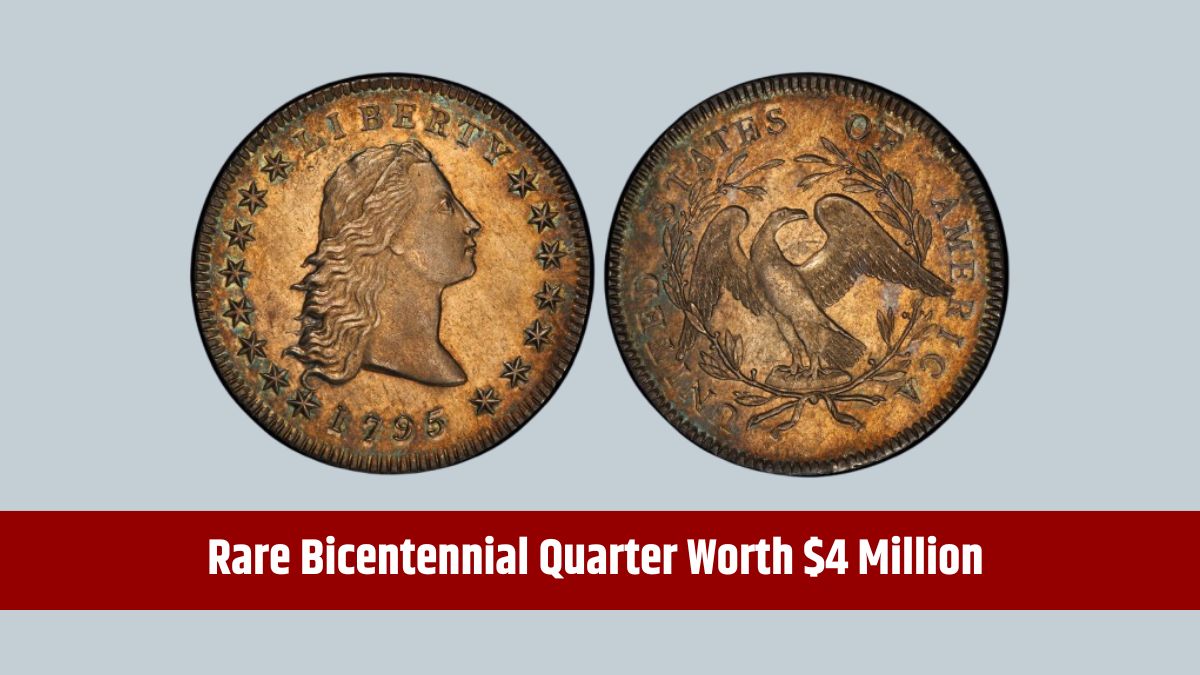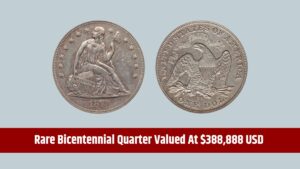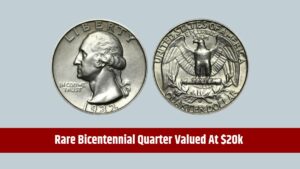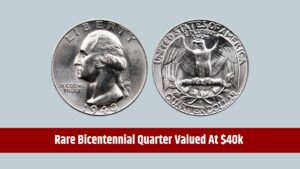The realm of coin collecting holds captivating treasures, each coin rich with history and astonishing value. Among these is the Bicentennial Quarter, a rare piece notable not only for its monetary worth but also its historical significance. Here, we cut into the story of this remarkable quarter and six other coins, each valued over $30 million USD, unveiling the allure of these extraordinary numismatic gems.
Bicentennial Quarter
Released in 1976 to mark 200 years of American independence, the Bicentennial Quarter usually holds a modest face value. However, a rare variant struck in 40% silver with a unique mint mark is valued at nearly $1 million. This highly collectible coin features a design with a drummer boy and a torch encircled by 13 stars, representing the original colonies. Its value comes from limited production, pristine condition, and its historical connection to the U.S. Bicentennial, making it an exceptional piece in any collection.
| Feature | Details |
|---|---|
| Year of Release | 1976 |
| Estimated Value | Nearly $1 million USD |
| Design | Drummer boy, torch, and 13 stars |
| Significance | Commemorates U.S. bicentennial, unique silver variant |
Flowing Hair Silver/Copper
As one of the first dollar coins minted by the United States government, the Flowing Hair Silver/Copper Dollar from 1794 and 1795 is valued at over $30 million. This coin holds a unique place in history as a symbol of the early United States. With Lady Liberty on one side and an eagle on the reverse, it represents ideals of freedom and unity. Its scarcity, age, and historical significance make it one of the most prized and valuable coins in the world.
| Feature | Details |
|---|---|
| Year of Minting | 1794–1795 |
| Estimated Value | Over $30 million USD |
| Design | Lady Liberty and eagle |
| Significance | First U.S. federal dollar coin, highly rare |
Double Eagle
The 1933 Double Eagle is one of the most famous American coins, valued today at over $30 million. Initially minted as a $20 gold coin, it was meant for circulation but was never released due to the Gold Reserve Act of 1934, which mandated the melting of most gold coins. With Liberty striding forward and an eagle in flight, the few Double Eagles that survived are highly coveted for their rarity and the legal battles that surrounded them.
| Feature | Details |
|---|---|
| Year of Minting | 1933 |
| Estimated Value | Over $30 million USD |
| Design | Lady Liberty and eagle in flight |
| Significance | Rare due to Gold Reserve Act of 1934 |
Brasher Doubloon
Minted by goldsmith Ephraim Brasher in 1787, the Brasher Doubloon is America’s first gold coin, valued at over $30 million. Produced before the establishment of the U.S. Mint, this coin symbolizes the early days of the U.S. economy. It features an eagle with a shield and the motto “E PLURIBUS UNUM.” Brasher’s personal petition to create his own coins and its historical significance make it a key artifact in American numismatics.
| Feature | Details |
|---|---|
| Year of Minting | 1787 |
| Estimated Value | Over $30 million USD |
| Design | Eagle with shield, “E PLURIBUS UNUM” |
| Significance | First American gold coin, predates U.S. Mint |
Saint-Gaudens Double
Renowned for its artistic beauty, the 1907 Saint-Gaudens Double Eagle is valued over $30 million and is considered a numismatic masterpiece. Designed by acclaimed sculptor Augustus Saint-Gaudens, the coin features Liberty holding a torch and olive branch, while an eagle flies on the reverse. Its high-relief design and intricate detailing make it one of the most beautiful U.S. coins, treasured by collectors worldwide.
| Feature | Details |
|---|---|
| Year of Minting | 1907 |
| Estimated Value | Over $30 million USD |
| Design | Liberty with torch and olive branch, eagle in flight |
| Significance | Roosevelt’s commission, designed by Saint-Gaudens |
Liberty Head Nickel
The 1913 Liberty Head Nickel, with a valuation of over $30 million, is one of the rarest coins in U.S. history. Only five specimens are known to exist, each struck in a year when no nickels were authorized for production. Featuring the head of Liberty on one side and a Roman numeral “V” on the reverse, this coin’s unintended creation adds to its mystique and value, making it highly prized among collectors.
| Feature | Details |
|---|---|
| Year of Minting | 1913 |
| Estimated Value | Over $30 million USD |
| Design | Liberty Head with Roman numeral “V” |
| Significance | Unauthorized minting, extremely rare |
Edward III Florin
The Edward III Florin, minted in 1343, is a rare medieval English gold coin valued at over $30 million. It bears the royal seal of King Edward III and represents one of the earliest English gold coins. Its age and rarity make it a highly coveted piece among collectors, as it embodies a fascinating period in England’s history and the emergence of its monetary system.
| Feature | Details |
|---|---|
| Year of Minting | 1343 |
| Estimated Value | Over $30 million USD |
| Design | Royal seal of King Edward III |
| Significance | Rare early English gold coin, medieval artifact |
These seven coins each hold a unique place in history, representing the artistry, culture, and values of their respective eras. From symbols of American independence to relics of medieval royalty, these coins remain extraordinary collectibles in the numismatic world, capturing the imagination of collectors and historians alike.
FAQs
Why is the Bicentennial Quarter valuable?
The rare silver variant with a special mint mark can be worth nearly $1 million.
What makes the 1933 Double Eagle so rare?
Most were melted due to the Gold Reserve Act, with few surviving examples.
How many 1913 Liberty Head Nickels exist?
Only five are known, making it extremely rare.
What is special about the Brasher Doubloon?
It is considered America’s first gold coin, minted before the U.S. Mint.
Why is the Edward III Florin so valuable?
Its rarity and status as an early English gold coin contribute to its value.









